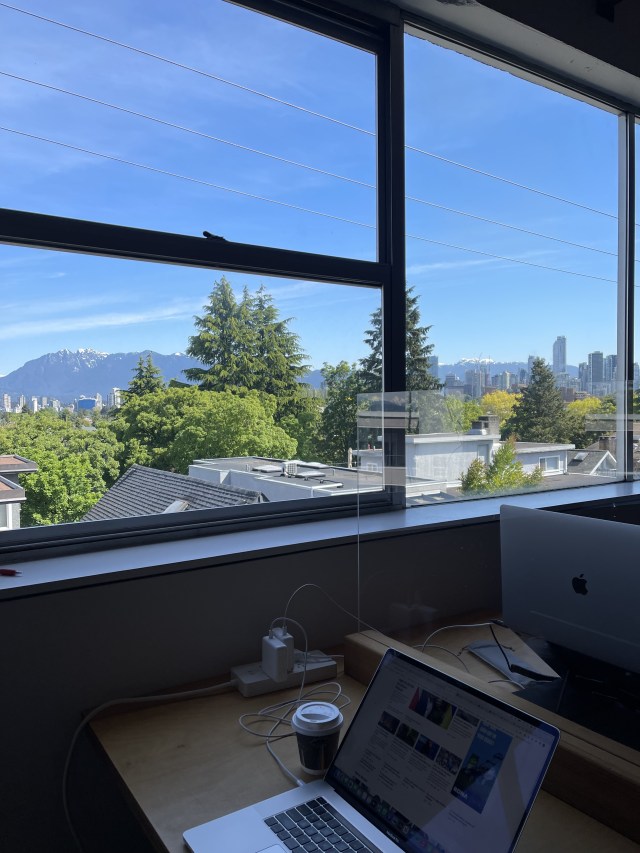Lockdowns provided a baptism of fire for many traditional office jobs, who were quickly faced with transitioning an entire team into remote work. Video collaboration software Zoom surged in popularity, pets were overwhelmed with the sudden company around the home, and elbows young and old jostled for space at the dinner table.
In February 2020, I was reporting at the ABC in Sydney on a mystery virus that was taking hold overseas after we had just finished covering the calamity of Black Summer, and it was perhaps a sign of audience fatigue that many seemed unwilling to entertain the concept that something enormous and unstoppable could be about to happen.
Walking into the newsroom one day, I was promptly given a laptop, a keyboard, and a second computer screen, and told to get a cab. It was working from home — but just for now, my manager qualified. Even with experts warning we were in for the long haul, I had no idea I would never return to the ABC office full-time.
Once I was set up at home, I was astounded by what I’d gained back from working remotely. Hours spent commuting from Bondi Beach to the heart of Sydney without salary compensation suddenly seemed fanciful, my uncomfortable office-appropriate pants seemed archaic, and the past’s microwaved lunch meals were slops compared to my stocked home pantry and oven.
But there were broader ethical benefits of remote work that quickly became apparent as we took to Twitter, Zoom and messaging to share our collective experiences. Friends or acquaintances with disabilities or anxieties could suddenly work from a comfortable, well-equipped home environment, the care of elderly, sick or young people became easier from the home office, and as it turned out, our eco-footprint was slashed by about 10%.
As it turned out, remote work wasn’t exactly a silver bullet. I was concerned by early reports that a hybrid work culture of presenteeism and remote work may be causing cause rising gender inequality in the workplace as more women choose to stay home for care or household labour reasons. Some women told The Guardian that they had been demoted or missed out on promotions because they were not as front of mind as their male counterparts in the office. Was that going to happen to me?
On a smaller scale, I also found remote work created a slightly lonelier existence for me, where water-cooler conversations — incidentally where inspiration about a great story or angle can often strike — fell by the wayside. More than once my fingers have hovered over the keyboard as I’ve mulled whether my wry comment or observation is really worth a notification on the other unknown end. As new staff joined the team, we formed tentative relationships far short of the type that a daily interaction would’ve formed between us.
Positive early pandemic habits, like a cheery morning walk or coffee before start time, invariably gave way to sleep until 20 minutes before I was due to start work. It was a scary, sad, difficult time as the fatalities climbed, 30th birthdays were missed, and parents in other cities seemed a world over. Like most, a sort of fog had set in, and sleep became a safe place.
Nowadays, with lockdowns lifted and a hybrid working model embraced by many workplaces that have adapted their processes to support staff, remote work feels completely different. The hybrid work model allows workers to enjoy the best aspects of the workplace — like connection, community, and brainstorming — and the best of remote work — like extra sleep, family time, and the opportunity to live a distance from the office (even in Vancouver, where I live!).
Though I’m not in the Private Media office, I am in a shared workspace with a gorgeous view of the snow-capped mountains. Dragging myself to (co-)work on rainy days can be a little tricky, but once I’m sitting at my desk, diligently typing away with the echo of twenty other keyboards in the back of my mind, it feels good. Like making a meal instead of eating fast food, it feels wholesome and healthy for me. A 2022 PwC Future of Work report said three days at home and two days in the office is the ideal scenario, but I find working from the office for half a day, four days a week is my sweet spot (I work Sunday to Thursday, and Sundays are spent working from home).


Hybrid work isn’t perfect. For those in hybrid teams who chose to eschew the remote work life and head into the office, they can find themselves left in the dark — literally. I was reading the Sydney Morning Herald this week where journalist and lawyer Erin O’Dwyer recalled moments when she went to the workplace only to periodically wave her hands above her head every 20 minutes “to keep the automatic sensor lights on”. Charlie Lewis and I had done the same thing several times on Wednesday when it was just him and I in the office.
Hybrid work might not be the ultimate working model as the years roll by and we are met with new and different challenges — a climate calamity among them. But if the pandemic has taught us anything, it’s that being adaptable in all aspects of our life can lead us through dark times and back into the light. As long as office sensor lights are replaced with normal bulbs, that is.

